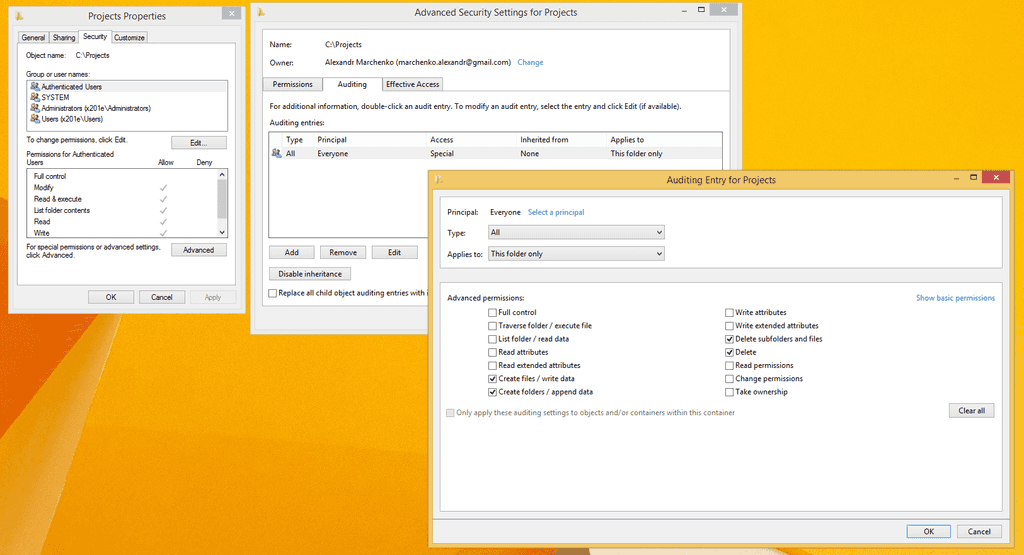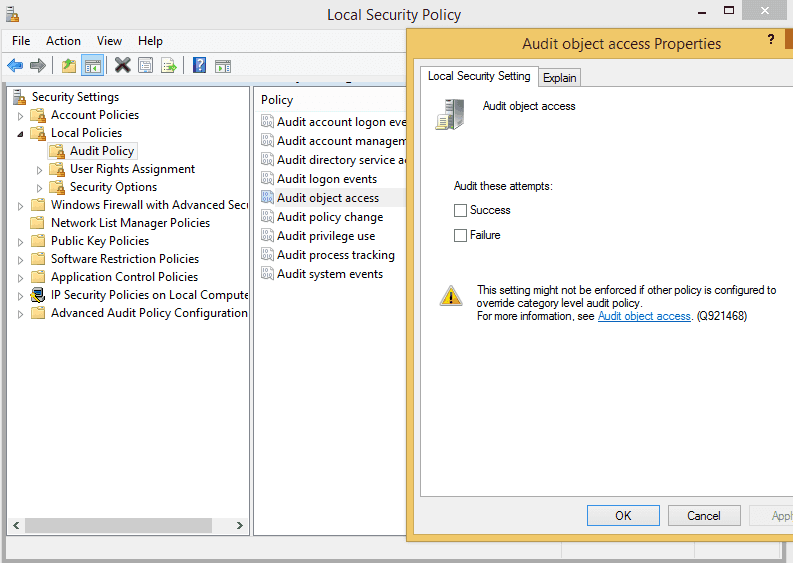Security Auditing
Did you know that you can monitor file changes without installing any additional software?
Watching for changes inside folder with Security Audition
Most sync software relaying on watching filesystem for changes to do the work.
In C# there is FileSystemWatcher for this kind of applications, which has IncludeSubdirectories property that will automatically catch changes from underlying folders.
But there is a way to monitor changes without any additional software written/installed on your machine.
So what we are going to do is to enable Security Auditing for changes made to any of children inside our object.
You can enable auditing any events you want, in our example we are looking just for file changes.
Here is powershell snippet to enable auditing changes:
$Path = 'C:\Projects'
$AuditChangesRules = New-Object System.Security.AccessControl.FileSystemAuditRule('Everyone', 'Delete,DeleteSubdirectoriesAndFiles,CreateFiles,AppendData', 'none', 'none', 'Success')
$Acl = Get-Acl -Path $Path
$Acl.AddAuditRule($AuditChangesRules)
Set-Acl -Path $Path -AclObject $AclAaron Giuoco has written good article describing this process in more details: http://giuoco.org/security/configure-file-and-registry-auditing-with-powershell/
Manage Audit Policies
Ok, so now when we have enabled auditing where can we see logged changes?
The answer is - in Event logs, but there is one more thing you should do before you will see your logs.
By default - logging of security auditing is turned off, you can enable it with secpol.msc
But here is what you should be aware of - if you are on Windows 8.1 (not Pro) you have no secpol snapin available :(
But there is still way to accomplish this, and it is even better: AuditPol.exe
Try run: AuditPol /get /category:"Object Access"
And you will see:
System audit policy
Category/Subcategory Setting
Object Access
File System No Auditing
Registry No Auditing
Kernel Object No Auditing
SAM No Auditing
Certification Services No Auditing
Application Generated No Auditing
Handle Manipulation No Auditing
File Share No Auditing
Filtering Platform Packet Drop No Auditing
Filtering Platform Connection No Auditing
Other Object Access Events No Auditing
Detailed File Share No Auditing
Removable Storage No Auditing
Central Policy Staging No AuditingYou can enable only desired auditing rather than all with command like this:
AuditPol /set /Subcategory:"File System" /success:enableFrom now on, you will see your security audit logs in event logs viewer.
Security log
Desired events will have 4663 EventID
Each event describes which object (file, folder) was modified in ObjectName and what operation was performed in AccessMask
To see template for event you can use following powershell snippet:
(Get-WinEvent -ListProvider Microsoft-Windows-Security-Auditing).Events | where id -eq 4663Which will show you what data passed to event and what is importang which index of event data is associated with which event detail
Id : 4663
Version : 1
LogLink : System.Diagnostics.Eventing.Reader.EventLogLink
Level : System.Diagnostics.Eventing.Reader.EventLevel
Opcode : System.Diagnostics.Eventing.Reader.EventOpcode
Task : System.Diagnostics.Eventing.Reader.EventTask
Keywords : {}
Template : <template xmlns="http://schemas.microsoft.com/win/2004/08/events">
<data name="SubjectUserSid" inType="win:SID" outType="xs:string"/>
<data name="SubjectUserName" inType="win:UnicodeString" outType="xs:string"/>
<data name="SubjectDomainName" inType="win:UnicodeString" outType="xs:string"/>
<data name="SubjectLogonId" inType="win:HexInt64" outType="win:HexInt64"/>
<data name="ObjectServer" inType="win:UnicodeString" outType="xs:string"/>
<data name="ObjectType" inType="win:UnicodeString" outType="xs:string"/>
<data name="ObjectName" inType="win:UnicodeString" outType="xs:string"/>
<data name="HandleId" inType="win:Pointer" outType="win:HexInt64"/>
<data name="AccessList" inType="win:UnicodeString" outType="xs:string"/>
<data name="AccessMask" inType="win:HexInt32" outType="win:HexInt32"/>
<data name="ProcessId" inType="win:Pointer" outType="win:HexInt64"/>
<data name="ProcessName" inType="win:UnicodeString" outType="xs:string"/>
<data name="ResourceAttributes" inType="win:UnicodeString" outType="xs:string"/>
</template>
Description : An attempt was made to access an object.
Subject:
Security ID: %1
Account Name: %2
Account Domain: %3
Logon ID: %4
Object:
Object Server: %5
Object Type: %6
Object Name: %7
Handle ID: %8
Resource Attributes: %13
Process Information:
Process ID: %11
Process Name: %12
Access Request Information:
Accesses: %9
Access Mask: %10Ashley McGlone has written goot article describing this things in more details: http://blogs.technet.com/b/ashleymcglone/archive/2013/08/28/powershell-get-winevent-xml-madness-getting-details-from-event-logs.aspx
So, now we can query our log to see what happens like this:
$Target = 'C:\Projects'
$EVENT_DATA_OBJECT_NAME_INDEX = 6
$EVENT_DATA_ACCESS_MASK_INDEX = 9
$EVENT_DATA_PROCESS_NAME_INDEX = 11
$ObjectNameExpression = @{
Name = 'ObjectName'
Expression = {
$_.ReplacementStrings[$EVENT_DATA_OBJECT_NAME_INDEX]
}
}
$AccessMaskExpression = @{
Name = 'AccessMask'
Expression = {
$_.ReplacementStrings[$EVENT_DATA_ACCESS_MASK_INDEX]
}
}
$ActionExpression = @{
Name = 'Action'
Expression = {
$AccessMask = $_.ReplacementStrings[$EVENT_DATA_ACCESS_MASK_INDEX]
if($AccessMask -eq '0x10000') { return 'DELETE' }
elseif($AccessMask -eq '0x2') { return 'WRITE' }
elseif($AccessMask -eq '0x4') { return 'APPEND' }
elseif($AccessMask -eq '0x6') { return 'WRITE|APPEND' }
else { return 'Unknown ' + $AccessMask }
}
}
$ProcessNameExpression = @{
Name = 'ProcessName'
Expression = {
$_.ReplacementStrings[$EVENT_DATA_PROCESS_NAME_INDEX]
}
}
#Get-EventLog -LogName Security -InstanceId 4663 -After (Get-Date).AddHours(-2) | select TimeWritten, $ObjectNameExpression, $AccessMaskExpression, $ProcessNameExpression | where ObjectName -Like ($Target + '*') | where AccessMask -in '0x10000', '0x2', '0x4', '0x6' | ft -AutoSize
$PastHourFileSystemSecurityLogEvents = Get-EventLog -LogName Security -InstanceId 4663 -After (Get-Date).AddHours(-3)
$Projection = $PastHourFileSystemSecurityLogEvents | select TimeWritten, $ObjectNameExpression, $AccessMaskExpression, $ActionExpression, $ProcessNameExpression
$FilterDesiredObject = $Projection | where ObjectName -Like ($Target + '*')
$FilterDesiredActions = $FilterDesiredObject | where AccessMask -in '0x10000', '0x2', '0x4', '0x6'
$FilterDesiredActions | ft -AutoSizeWhich will give you:
TimeWritten ObjectName AccessMask Action ProcessName
----------- ---------- ---------- ------ -----------
09.05.2015 13:32:39 C:\Projects 0x2 WRITE C:\Windows\explorer.exe
09.05.2015 13:32:39 C:\Projects\foo.txt 0x10000 DELETE C:\Windows\explorer.exe
09.05.2015 12:43:23 C:\Projects 0x2 WRITE C:\Windows\explorer.exe
09.05.2015 12:43:23 C:\Projects\New Text Document.txt 0x10000 DELETE C:\Windows\explorer.exeTake a note here, all this can be written in one line, it is just a note for me to remember how this is done.
As about event viewer you can use something like:
$xml = @"
<QueryList>
<Query Id="0" Path="Security">
<Select Path="Security">
*[EventData[Data[@Name='ObjectServer'] and (Data='Security')]]
and
*[EventData[Data[@Name='ObjectType'] and (Data='File')]]
and
*[EventData[Data[@Name='AccessMask'] and (Data='0x10000' or Data='0x2' or Data='0x4' or Data='0x6')]]
and
*[System[(EventID=4663)]]
</Select>
</Query>
</QueryList>
"@
Get-WinEvent -FilterXml $xmlBut unfortunatelly starts-with is not supported, so you can only see all security events.
What next?
Imagine you have two machines: MachineA, MachineB each of them have Projects folder which you want to sync.
You can not use Dropbox, OneDrive etc just because they do not allow to ignore specific folders.
You do not want use BitTorrent Sync just because you do not like it.
You can: Configure watching for changes in desired folders on each machine.
Then by event or schedule check which machine has latest changes and run robocopy to sync them. With robocopy you will be able to exclude folders like node_modules from being synced - profit.
Note: To not get into infinite loop - while checking last changes you should filter changes made by robocopy itself, this is why we are looking at ProcessName in logs.

